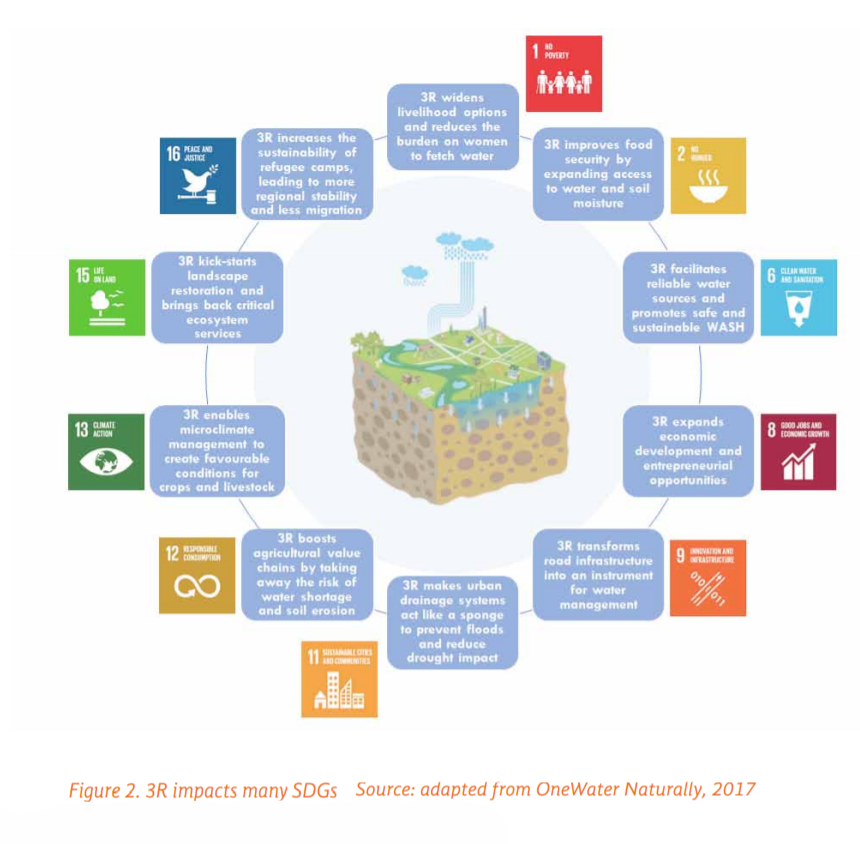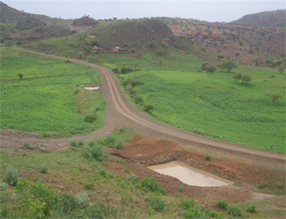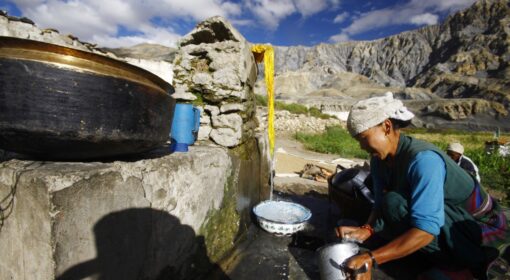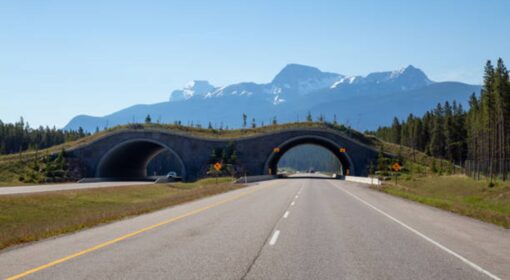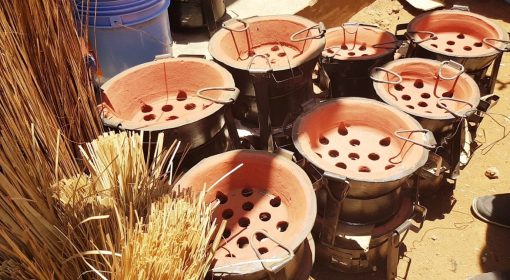We have a deal for you…
Posted by Frank van Steenbergen
March 23, 2018
We have a deal for you. The deal is to invest on a large scale in the capture of rainfall: to collect rainfall, run-off and floods: to retain these, store these and to use this water when required.
There is by now good evidence that where this is being done, the resource base convincingly changes for the better. Rather than letting rain and runoff cause damage, it is stored in the ground and in this way turned it into asset: more groundwater, better soil moisture. This assures better water buffers, more food security, generally more fertile soils, conducive local microclimates and less erosion or degradation.
The approach we advocate is called 3R – or rainwater harvesting at scale. Water is recharged in the soil and ground layers. It is retained there and reused when required – during dry periods or as an additional source of water. In this way a hydrological buffer is created. Once such a good water buffer, it is easier to retrieve the water that is recharged and to make use of water that was captured during peak rain during dry periods or dry spells. Retaining more groundwater can also create a different and more productive soil environment: more moist and fertile, because soil micro-organisms are able to fix nitrogen. 3R stands for the three steps to harvest rainwater at scale: recharge, retention and reuse. (Steenbergen et al., 2011).
Best practices and most promising opportunities vary with local conditions: the climate, local economy, topography. There however a wide variety of 3R practices, all appropriate in particular contexts. The practices range from on-site water harvesting structures to improved water infiltration systems such as terraces, contour bunds, tree lines, recharge wells, basins and infiltration trenches to interventions at the landscape level, like reforestation, riparian buffers, infiltration trenches, water spreading structures and spate irrigation (Scanlon et al., 2012). Every area and every has its own best opportunities.
What we want to convey is that is that the intensive harvesting of rainwater can contribute to many of todays challenges, as agreed in the Sustainable Development Goals. In addition, 3R programmes make business sense as well: they reduce the cost of providing services, such as water supply or safe infrastructure or increase the efficiency. In many cases they may generate revenue streams of their own. Then there are also a considerable gains by avoiding the cost of not replenishing groundwater resources, as without this intense use of groundwater can undermine local economies.
In the past ten years intensive rainwater capture as in 3R has transformed several areas. We believe many more can happen still and that with a sincere effort and large movement many million more people can benefit from the systematic recharge, retention and reuse of rainfall. This invitation is addressed to those that work on these different development challenges and those that in different ways invest with financial resources in impact that is created.
Here are eight challenges – where 3R can make a significant contribution – covering a large part of the SDG agenda:
- contribute to clean water and more secure WASH services (SDG6)
- contribute to zero hunger and responsible production of quality food by more reliable water supplies for farming (SDG 2 and SDG12)
- contribute to sustainable cities and communities by enhancing their water supplies and reduce the risk of urban floods (SDG11
- contribute to less down time and more beneficial use of road infrastructure by making roads instruments of water management (SDG 9)
- contribute to peace and justice by better living conditions in settlements of displaced persons (SDG16)
- contribute to better life on the land – in rehabilitated watershed and safe deltas (SDG15)
- contribute to cllmate action, in particular the promotion of more resilient micro-climates that buffer against climate change and create (SDG13)
We briefly discuss the different deals here – they are explained in detail in a separate deal book. (Click here to download)
Contribute to clean water and more secure WASH services (SDG6)
Currently, water scarcity affects more than 40 per cent of the global population, a number that is expected to rise (UN, 2017). The current best estimate is that moreover still 780 million people do not have access to an improved water source. This very much includes the ‘last mile’ – those hard to reach, living in relatively remote places, without access to safe water resoources. With many regions – especially those situated in the dry regions of the world – rapid population growth and ambitious economic plans increases the competition for limited water resources.. Added to this are new unpredictabilities introduced with climate change. What all this this means is higher failure of existing wells and springs and more difficulty in developing new resources. The importance of reliable WASH hardly needs explanation: at a basic level lower incidence of waterborne diseases such as dysentery and typhoid, thereby also being one of the factors driving high child mortality rates (Hutton, 2012) and the next level more secure living environments.
It is important to factor in the development of reliable sources of water into the increased coverage of WASH – to secure access to water in the most difficult (dry) areas but also to neet the demand where it is highest, such as in fast growing fringes of cities. The capture of rainwater offers a large opportunity to increase the supply and needs to be complemented with measures to safeguard quality. There is also scope to think of new business models, such as the RAIN4Sale concept that tests the business case of selling stored rainwater by local entrepreneurs in urban and peri-urban environments. This can be combined with the development of Smart Centres, whereby employment is generated in providing WASH services through local business – thus addressing the odd paradox of no services being provided and the same still much youth unemployment.
Contribute to zero hunger and responsible production of quality food by more reliable water supplies for farming (SDG 2 and SDG12)
A second main challenge is to feed and nourish the world and to provide jobs that go with this. The world needs to produce an estimated 60 percent more food from 2010 to 2050 to ensure global food security (FAO, 2015). Food habits are becoming more balanced – it is not only more food but also better food. A horticultural revolution has taken place – with more fruits and vegetables on the table, that need more precision water supplies that can be provided by reliable groundwater resources.
Agriculture moreover remains a large employer. Around 2.5 billion people, who manage 500 million smallholder farm households, provide over 80 percent of the food consumed in much of the developing world, particularly Southern Asia and sub-Saharan Africa (IFAD, 2013). There is a move to source supply sustainably by 2020 and invest in smallholders. Part of the transition is to reduce the chance of crop failure and move to high value products. Case studies and on-going work in horticultural value chains demonstrate that through simple combinations of water harvesting and better moisture management production of cash crops and subsistence crops can go up 40 percent (Fox et al., 2005, Kisekka et al., 2018).
Contribute to sustainable cities and communities by enhancing their water supplies and reduce the risk of urban floods (SDG11).
Cities are already the home of almost half of the global population, with estimates that around 66 percent of the global population will live in urban areas by 2050 (UNESA, 2014). There is a large growth of mega-cities (Cohen, 2004). Smaller towns and cities with less than 500,000 inhabitants are also flourishing. The UN estimates that more than 50 percent of urban population growth in the near future will be in such smaller towns and cities (UNPD, 2011).
There is a range of water challenges connected to urbanisation. The harder surfaces in cities and town reduces rainfall infiltration into the soil and increases surface runoff and waterlogging. Water which would have been infiltrated in forests and grasslands and stored in natural depressions now flows immediately into rivers and urban wetlands and increases the risk of urban flooding (Konrad, 2014).. However, as in elsewhere in cities rains and local run-off can be considered an asset. The sponge city concept, taking off in particular in smaller towns anc cities in China, Taiwan and Kenya reverts this paradigm. In sponge cities urban flooding is controlled, but also to retain 70-90 percent of annual rainwater is retained by applying green infrastructure such as vegetation and permeable pavements, urban infiltration basin, sand dams, but also managing urban wetlands to store excess water and provide waste water treatment.
Contribute to less down time and more beneficial use of road infrastructure by making roads instruments of water management (SDG 9)
Intensive capture of rainwater and runoff can also be combined with the development of new road and highway infrastructure. The basic concept is that of transforming roads into instruments for water management. Roads have a substantial impact on watershed hydrology. This impact is often negative and is now often leads to roadside flooding, erosion, sedimentation and water logging. In a typical rural there may be 6-25 such hotspots per 10 kilometer. At the same time water causes 35-80% of all damage to roads – translating in high maintenance or low reliability.
Yet this can all be turned around. As roads block water, guide water, concentrate the run-off in limited drainage canals and affect sub-surface streams, this effect can be used to harvest water rather than causing damage. In a nation-wide movement in Ethiopia an investment of USD1800 per kilometre created an eight fold benefit per year – attributed in equal measure to reduced landscape damage, reduced down time costs of roads and beneficial use of water captured by raods. With an annual investment of 2.1 Trillion in roads globally, combining 3R measures into road development can make a huge contribution to water security and more reliable access. This is particularly true for the ubiquitous unpaved roads where funds for maintenance are generally in short supply and preventing damage is essential.
Contribute to peace and justice by better living conditions in settlements of displaced persons (SDG16)
There is unfortunately no let down in manufactured chaos in the world. In 2016 UNHCR registered 65.6 million people displaced globally. Amongst these were 10.3 million newly displaced in just that year. A large portion of these people stay in camps the size of a small or medium-sized city which is developed almost overnight. The quick conversion of any place into a temporary shelter can have a devastating impact with the area stripped of vegetation and water resources not understood and over used in a short time. Improving land and water resources in such places with 3R solutions is most relevant,. Many of these area are the abode of distressed people adjusting to a new lide. The actual practices is that many of the temporary settlements are in place for many years and that if managed well they may even be left behind better.
Contribute to better life on the land – in rehabilitated watersheds (SDG15)
The core of 3R is transforming landscapes and transforming lives ( ). Socio-economic development, i.e. growing populations, , migration, intensification and expansion of agriculture and industrialization, result in severe overexploitation of natural resources, environmental degradation, and loss of ecosystems services. The carrying capacity of landscapes is stretched. One immediate consequence is that goods and services sourced from landscapes will decrease (fuel wood, timber, biodiversity, soil and water retention) – cascading into reduced agricultural production, loss of safe water sources, and a fall in household income. The associated competing claims result in a steep rising in social conflict. According to a global assessment of restoration potential, there are more than 2 billion hectares of deforested and degraded land around the world where opportunities for restoration may be realised.
Adding 3R to landscape restoration initiatives can yield great benefits. A study in the Gule sub-watershed in northern Ethiopia measured the effectiveness of in-field measures – tied ridges, wheat-straw mulch and addition of effective micro-organisms (Woldegiorgis, 2017). It was found that runoff and soil loss can be reduced by 49 to 90% respectively. Anoher example from Ethiopia is the Sukhomajri watershed development programme which resulted in a six-fold increase in milk production. At the same time downstream siltation rates and dredging cost were reduced by 95% (Marginnis & Jackson, 2005). For the best results, it is crucial to select 3R measures based on soil type, vegetation cover, slope and amount of rainfall and local economy
Contribute to better life on the land – in deltas (SDG15)
Currently, about 50% of the global population lives within a range of 150 km from the sea (Cohen et al., 1997). The high population density in deltas and coastal areas coincides with a clustering of economic activities, transportation and services (Olsen et al., 2003). At the same time deltas are vulnerable: fresh water availability in deltas is under serious threat due to sea level rise, land subsidence, aquifer overuse and pollution.
Water resources need to be better protected and managed to ensure sustainable level of services, including the agricultural production feeding these coastal areas. A particular and widespread water challenge in coastal areas is saline water intrusion and the consequent salinization of soils. This leads to changing groundwater dynamics and a serious reduction in agricultural opportunities. There is a range of 3R measures that can help to mitigate the pressure by replenishing and protecting the vital coastal aquifers. These measures include recharging run-off so as to create fresh water lenses on top of saline groundwater, creating more surface storage by excavating depressions whereas at the same time raising built-up land; using low coastal dams to prevent sea water intrusion and retain freshwater upstream or controlled pumping regimes. There is a large range of cost effective measures to ensure the long-term viability of these economic heartlands.
Contribute to cllmate action, in particular the promotion of more resilient micro-climates that buffer against climate change and create (SDG13)
By retaining more rainwater in the landscape we change its micro-climate. Retaining more water in the soil affects the temperature of the soil, but also air moisture and air temperature. Re-greening similarly influences wind patterns and wind speeds and with it the distribution of small particles, the drying of land and the local evaporation from trees. What all of this in principle can do is to buffer the local climate and make it more resilient to global climate change. This maybe more cost effective than adaptation or mitigation. Moreover, creating a better micro-climate at landscape level – more moist and sheltered – and less affected by temperature peaks for instance – will safeguard the growing range
All crops have an optimum temperature for germinating and growing. Maize for instance is hindered above 35°C, while onion has a maximum temperature threshold of 25°C. For shade crops like coffee, the effect is even stronger. The optimal range of Arabica is 18-21°C, with reduced photosynthesis between 24-34°C, and no photosynthesis above that (Lin, 2007). When these temperatures are exceeded, growth is delayed or stopped. The opposite happens when the local micro-climate is carefully managed with 3R and re-greening measures:. Increased maize yields of up to 45% have been measured downwind from windbreaks, the best result at 4 to 5 tree heights from the windbreak. Also, milk yields may be improve by 16% if grazing cattle is not exposed to strong winds (Caborn, 1957).
A deal .. in many directions
The deal is in many directions. Investing in rainwater harvesting does not just solve water scarcity. It creates impact in achieving SDGs and generates more jobs and investment opportunities. It secures the economy, safeguards agricultural production, facilitates urban growth, ensure essential services from water supply to transport and creates landscapes, deltas and micro-climates that can deal better with shocks but also provide more services. It also avoids the cost of doing nothing. The negative externality in terms of global health, security and economic risks are huge. We see the promotion of 3R as an investment opportunity – for those that directly benefits and those that want to invest in proven impact.
We argue to use an outcome payment model for rain water capture to stimulate cohesion and to realise collaboration in a multi stakeholders approach with a social and financial return on investment proposition for four main financial streams: public finance (including ODA), impact investment, private capital and philanthropy. The business model is using outcome payments as contingent payers for the results of water related interventions which
- either prevent the negative externalities identified per stakeholder (private capital markets and private sector players)
- and/or monetise the positive social and public effects and the willingness to pay for these outcomes (major task for philanthropy and public investments)
- and /or with a risk taking support from ODA (either de-risking first loss and/or capacity building)
- to trigger impact investors, offering them return from margins (from the business case) and social benefits (monetised by ODA and philanthropy)
We believe many more can happen still and that with a sincere effort and large movement many million more people can benefit from the systematic capture of rainfall.. We live in a still incomplete world, where many are vulnerable and exposed and the future is not secure. At the same time there are many opportunities unfulfilled but also efforts and financial resources not directed to social business impact. We need to redirect and be sincere with what we do with out time and money.
Rain is a blessing and it always has been. It is time to act and invest.
